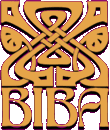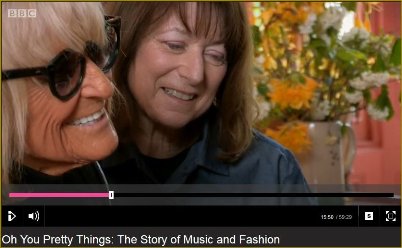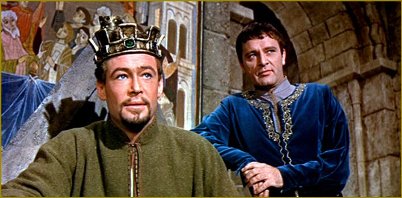Back to Biba Home Page / Back to Home Page
2017 - New Book / Old Poster
Barbara did a lot in and around Poland in 2017 revisiting her roots. I was glad to see it because everybody knows she's Polish but they don't seem to treat her as if that part of her life was and always should be an integral part of her existence. Like me she has an easy to use and pronounceable, translatable (first or Christian) name Barbara/Anna. Everyone knows 'Hulanicki' is her maiden and trade name - but 'Hulanicki' is actually her father's name and she would have been 'Hulanicka' just as her aunt was in the fabulous poster I found of her by Gronowski! My maiden name was 'androgynous' if you like and didn't allow for denoting gender unless you used the very old-fashioned pre-war version .... so both of us can disappear into the anonymity of the Anglo-Saxon heritage we didn't inherit! We both also married men whose surnames allow us to continue being privately anonymous! The biggest difference is that I speak Polish and have kept it up and if I were to have appeared on Polish Tv I would have spoken in the host language ... so at times it seems to me that Barbara uses her Polishness as a convenience; I use my dual-nationality to honour my parents as Poles and my allegiance as a British citizen. So it annoys me greatly that my (hitherto) great heroine cannot even acknowledge that it was I who found a poster of a woman she mentions in her new book (published in Polish) but cannot even thank a fan for this great find! I shall always enjoy my time as a Biba Girl and until this moment, even after having got to know her sister and brother-in-law well (from whom she is estranged), I don't think I'll ever admire her again because of this :
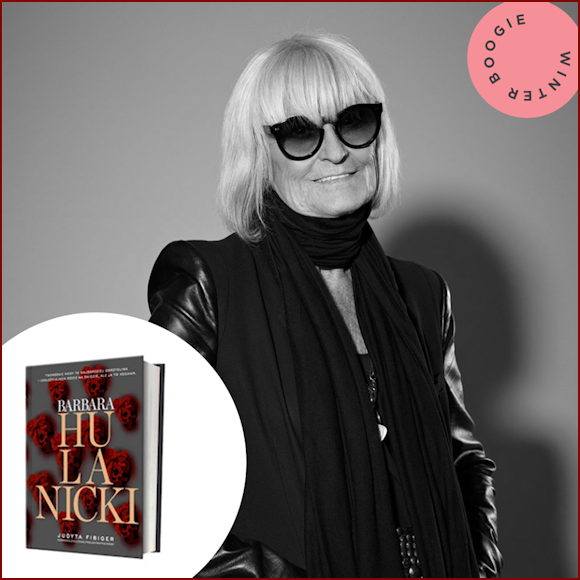
The new book which even has an Fb page of its own!
On November 6th I posted the image of 'Hulanicka' and asked if this was the aunt mentioned in the book and added the artists information.
My 'feed' informed me that the photo had been 'liked' and a comment had in fact been left by the author stating that she was only the author but confirming that this poster was that of Hulanicki's aunt (see larger image above)
On November 16th Barbara posts the image that I had put on her book site without naming the artist or crediting me!
Having checked back to the book page and discovering that the poster was not longer there, on 25th November, having given plenty of time to pass by for a fitting response, I challenged Barbara and dated when I had left the original post.
Two days later a grudging (perhaps?) confirmation by 'liking' the comment.
Seriously? People, with a high profile, in the public arena should behave a little more politely!
2014 - Shop Girls - the 'True Story'

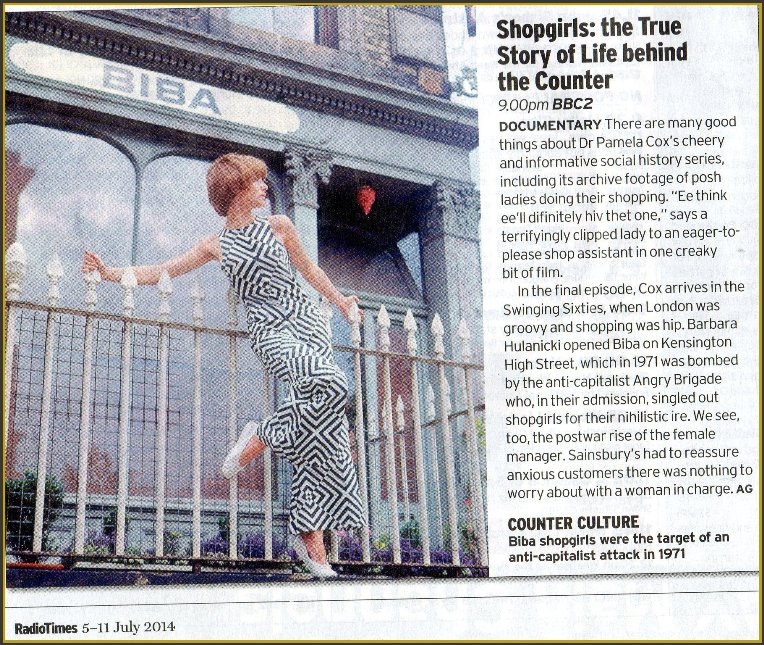
Of course you cannot have a programme about shop girls without Biba featuring!
2014 - 'Oh You Pretty Things'
Still wowing them in 2014 - new book 'The Biba Years' and BBC showcase series 'Oh You Pretty Things' described as a 'Series exploring the relationship between British rock and pop music and fashion.'
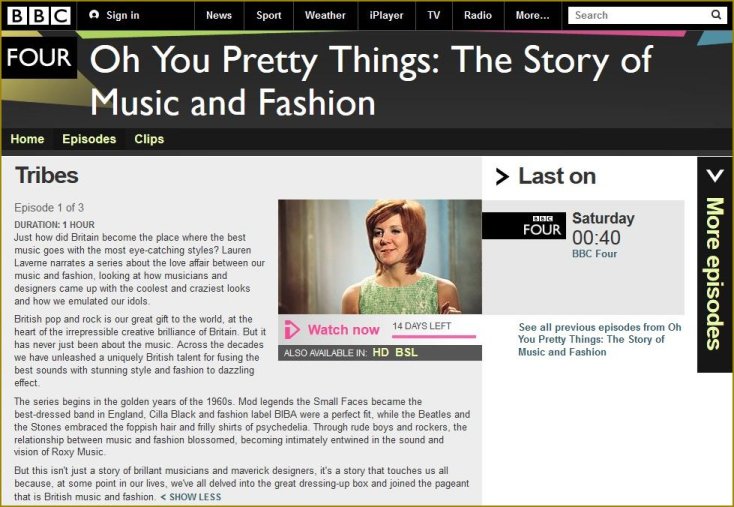
Episode 1 - Tribes
'Just how did Britain become the place where the best music goes with the most eye-catching styles? Lauren Laverne narrates a series about the love affair between our music and fashion, looking at how musicians and designers came up with the coolest and craziest looks and how we emulated our idols.
British pop and rock is our great gift to the world, at the heart of the irrepressible creative brilliance of Britain. But it has never just been about the music. Across the decades we have unleashed a uniquely British talent for fusing the best sounds with stunning style and fashion to dazzling effect.
The series begins in the golden years of the 1960s. Mod legends the Small Faces became the best-dressed band in England, Cilla Black and fashion label BIBA were a perfect fit, while the Beatles and the Stones embraced the foppish hair and frilly shirts of psychedelia. Through rude boys and rockers, the relationship between music and fashion blossomed, becoming intimately entwined in the sound and vision of Roxy Music.
But this isn't just a story of brilliant musicians and maverick designers, it's a story that touches us all because, at some point in our lives, we've all delved into the great dressing-up box and joined the pageant that is British music and fashion. '
As Cilla makes her striking entrance at the Palladium for her debut Royal Variety Show performance before HM Queen Elizabeth what links this moment?

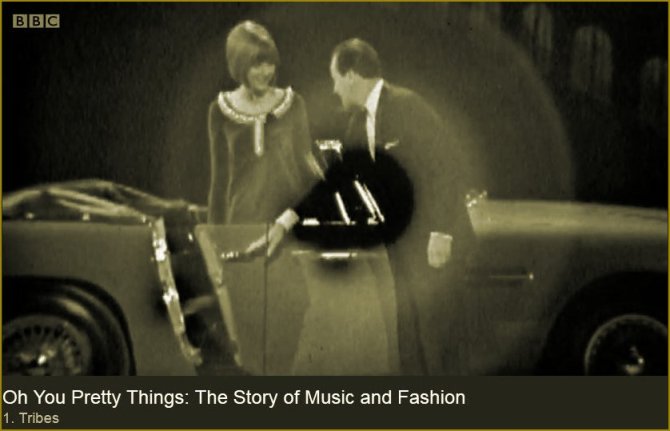
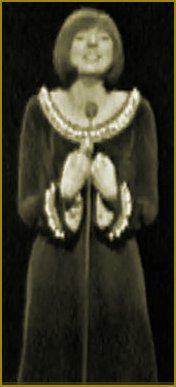
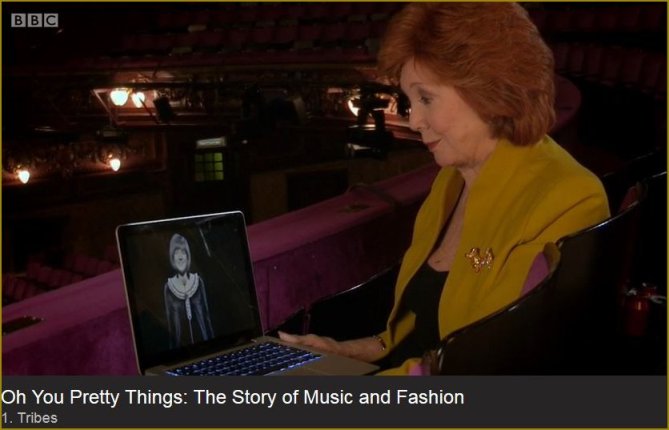
From the top : A portrait of Cilla from that Royal Variety Show performance in 1964 followed by a screen shot (sorry about the quality) of her spectacular arrival on stage in a sports car. Cilla was a new star whose debut performance followed stalwarts Morecambe and Wise and 'our' Gracie, well known to the monarch. Cilla reviews her own performance many years later and pronounces that the girl in the stunning frock was terribly nervous and it could be heard in her voice. Cilla was not the only nervous person that day, Barbara Hulanicki admits her nerves as she also looks on the historical performance. She tells us that the dress was based on a costume worn by Richard Burton in 'Becket' and admits that it doesn't 'look as bad' as she thought it would with the passage of time. Considering the impact Barbara's designs have made and how fondly they are still remembered, she started off with quite humdrum and conventional designs despite trying to break away from the mould!
2014 - The Biba Years
Viva Biba: The iconic fashion label's founder Barbara Hulanicki tells her extraordinary story
00:02, 24 August 2014 |
Fifty years ago, the first Biba shop opened in London and started a fashion revolution. Here Barbara Hulanicki, the woman behind the legend, tells her extraordinary story
A Biba 'op art' piece is modelled outside the original Biba store in Abingdon Road, Kensington, 1965 © David Graves / Rex Features
I was born in Warsaw in 1936, but my parents then relocated to Jerusalem where my sisters were born – Beatrice in 1938 and Biruta, nicknamed Biba, in 1942.
From an early age, clothes were more than a mere necessity for me. I must have been such a pain for my mother because I didn’t want to wear the same clothes as my sisters.
I hated those great pouffy knickers which felt like a balloon underneath our smock dresses. We all had to wear matching clothes. I rebelled and refused to have the same red shoes my sisters had, so my poor mother had to find me others.
It was tough in Jerusalem because there weren’t many shops. My mother used to make aftershave for my father, her own witch-hazel tonic and face creams because you couldn’t buy anything. You had to make or sew everything and my mother was amazing, forever making clothes and stuff for the home.
My father’s work with the British Mandate for Palestine [the British ruled Palestine from 1917-48] meant that he could travel and shop abroad. He would go to places such as Beirut and my mother would beg him to bring her something – Lebanon had fantastic French clothes because of the French occupation. I remember he once brought her back a two-piece bathing suit which was knitted. We used to rent a house on Lake Tiberias [the Sea of Galilee] and she went swimming there and couldn’t get out because it had stretched when it got wet!
Barbara with her beach design in the Evening Standard, 1955 / Cilla Black and Cathy McGowan help out
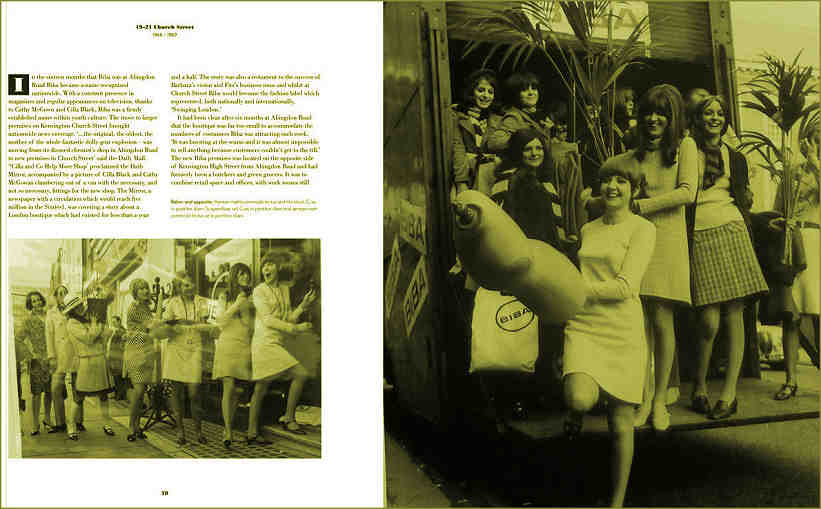
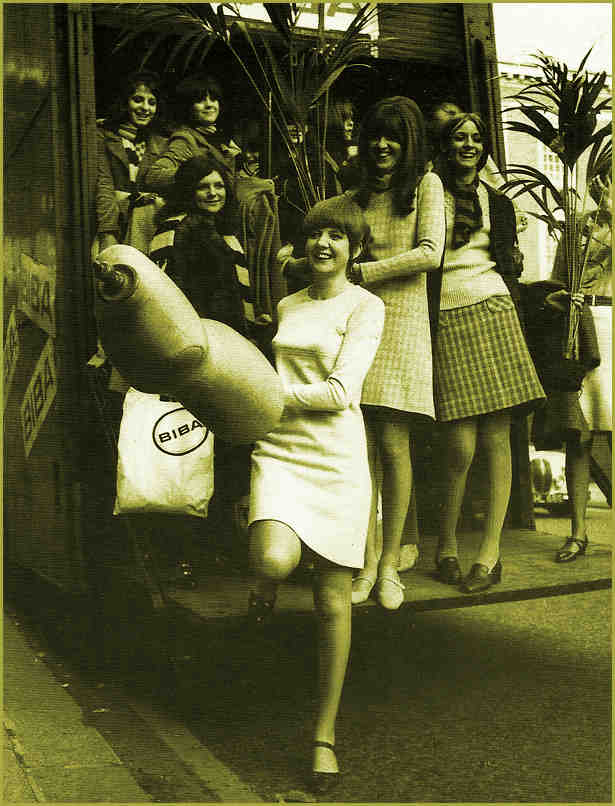
Some unusual help, not quite your every day shop girl "Cilla Black & Cathy McGowan helping with the move from Biba in Abingdon Road to the new Biba premises in Church Street (1966)"
Our life in Jerusalem came to an abrupt end in February 1948 when my father was taken from the family home. His body was found the following day, his hands tied and a bullet through his temple. He had been murdered with the Polish journalist Stefan Arnold by the paramilitary group Lehi, also known as the Stern Gang, who violently opposed the British presence in Jerusalem and its supporters.
The last days of the British Mandate, which ended on 14 May 1948, saw Palestine, and particularly Jerusalem, fall into a state of lawlessness as conflicting factions sought to take control of the region. It is unlikely that the truth of my father’s death will ever be known. But it now seems that he was a casualty of the Cold War, as militants aligned themselves with the anti-British, Soviet-led Communist regime in Poland, for my father’s name was at the top of the list of those to be assassinated by the new Communist Polish government.
My mother was in a terrible state, and terrified about the future there with three young children. Thank God the British government was so kind to her. They looked after her and put us on a plane to England with the troops, and within a fortnight we had relocated to Brighton under the apparent benevolence of my mother’s widowed and childless half-sister, Sophie Gassner.
Aunt Sophie had been left her husband’s fortune, made in the cotton industry, on his death five years earlier. Her halcyon days had been in the 1930s with an endless stream of cocktail parties, couture outfits and planning for the summer season. Couturiers Jeanne Lanvin, Jean Patou and Coco Chanel created outfits for her, which she complemented with a collection of furs and jewels. It was an era she decided not to leave, dressing daily in her silk crepe and satin gowns.
Barbara with her father Witold and sister Beatrice (left), 1940
Aunt Sophie saved my family from an uncertain future, but the price was subservience: all decisions were made and paid for by her. I lost myself in the films of Hollywood, with stars such as Greta Garbo, Grace Kelly and Audrey Hepburn, to escape from the loss of my father and my domineering aunt, imagining a more independent life for myself.
In the 1950s, buying affordable and fashionable clothes became a preoccupation. Making up garments from paper patterns was one option, although not always that successful because I got bored. My mother couldn’t stand seeing these half-made things so she would have to finish them off and I remember forever saying, ‘No Mama, make it tighter!’
Pinstripe trouser suit, 1964 - 'This was one of the first designs we worked on. It was deeply personal for me because the last time I saw my father, he was wearing a pinstripe suit. When Cathy McGowan [presenter of pop music tv show Ready Steady Go!] first wore a trouser suit to the Savoy Hotel in 1965 she was thrown out. It was all over the papers. Our trouser suit, which sold for seven guineas, was our first notable success in terms of sales' / Riding mac, 1968 - 'This was inspired by Burberry and it kept selling out. We stocked it for nine years, and you'd think that after all that time there'd be no problems, but one delivery arrived with a sticky-out dart at the top of the sleeve - I nearly had heart failure. It didn't look right, but sold all the same. When we took some designs to New York, a large department store liked the mac with the strange darts so much that they bought it! They thought it was classic Biba'
Aunt Sophie wanted me to go to university but I ignored her wishes and went to Brighton College of Art instead. I remember entering a fashion contest run by the Evening Standard with a panel of four judges including Norman Hartnell, couturier to my aunt. She told me to submit a design for a fussy day dress. But I also entered a design for an Italian-style beach outfit in candy-coloured cotton with a white eton collar. I imagined Audrey Hepburn wearing it in Sabrina. My design won the beachwear section of the competition and Aunt Sophie was not pleased. I remember there was this stony silence as she regained her composure.
Norman Hartnell’s couture house made up each of the winning designs and I went with my aunt to his Bruton Street salon in Mayfair to be presented with the outfit. That was my first introduction to the world of couture and it was a great shock: for in the hands of a couturier my soft cotton outfit became a silk taffeta confection more suited to a cocktail party than a beach holiday – but of course they wouldn’t have used cotton, it was much too downmarket. Winning that competition gave me the confidence to leave art college before the course was over and start work as an illustrator in London, and it was there, in the late 1950s, that I met my husband Stephen Fitz-Simon, who was working in advertising.
He was the person who really encouraged me to start designing. He could see that photography was coming in and about to take over from illustration, which would put me out of a job, so in 1963 we launched a fashion mail-order company together. Mail order grew at an unprecedented rate during the 1960s, outstripping all other forms of retailing, and for a small company like ours it was the most economical way to operate.
I didn’t want my own name associated with it. I wanted people to focus on the concept of our company – inexpensive fashion for everyone – rather than a personality. We decided on Biba, my little sister’s nickname. It was feminine and unusual, a name people could bring their own ideas to.
By the spring of 1964 we were struggling to fulfil the huge number of orders we were receiving for our first big hit – a pink gingham dress [see page 65]. So on 5 September 1964, we opened the doors to our first shop at 87 Abingdon Road in Kensington, and without advertising or even a sign on the door, we sold out the stock on the first day.
This is an edited extract from The Biba Years 1963-1975 by Barbara Hulanicki and Martin Pel, to be published by V&A Publications on 5 September, Biba’s 50th anniversary.

The last word went to Twiggy :
Twiggy in a leopard-print coat, 1973 - 'I love this photo because so few were taken in the Big Biba shop. We made this coat for Twiggy. She was very special to us, and it was never work with her, just fun. We did a three-quarter-length version without a hood, which was a huge seller, too. I think I've still got one in London. It's too hot to wear in Miami, where I live now' - © Getty Images
'I think there should be a plaque on 87 Abingdon Road. Biba transformed the way the ordinary girl in the street dressed. It was a tiny corner shop, an old chemist in a quiet residential street. But before long, Biba was mecca to everyone from shop girls to debs. Not only did the clothes look amazing, you could afford to buy something every week.' - Twiggy, from Twiggy in Black and White, 1997 '
Original Iconography
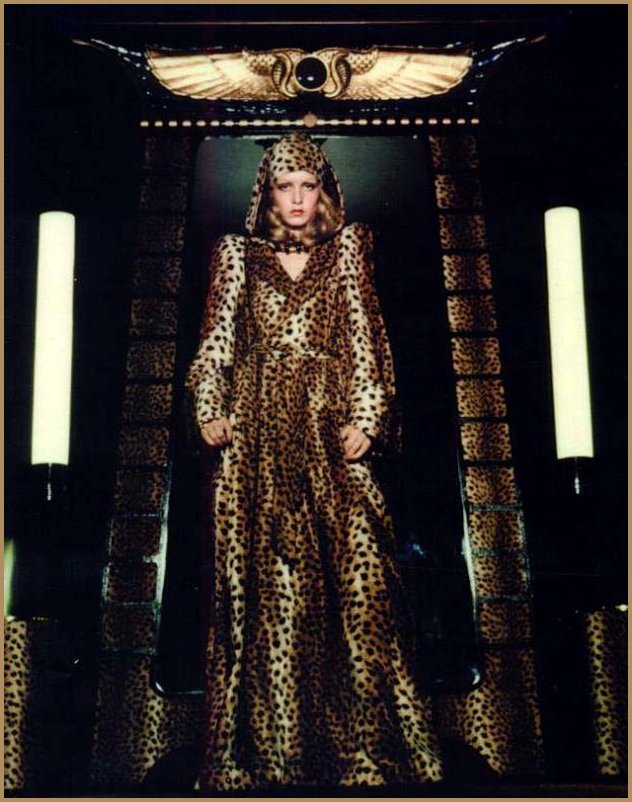
Twiggy models a Biba faux fur Leopard Jacket at Big Biba. Photo by Justin De Villeneuve.
2009 -
The sexiest shop on Earth: The uproarious story of Biba, the store that defined the Sixties
From the Daily Mail by Glenys Roberts Updated : 17:07, 30 July 2009
There was a time when my wardrobe was full of nothing but Biba. My favourite frock was a clinging chestnut calf-length number with a blouson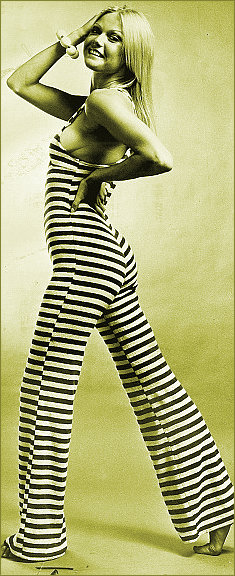 top and elbow-length sleeves that looked like something Lauren Bacall would have worn in Key Largo. I had a huge floppy picture hat in the same colour, which would have looked great on Katharine Hepburn. For glam evenings, there were Biba's ostrich feather boas, stunning double breasted macs, trailing Isadora Duncan scarves in bold Art Deco prints, white satin pyjamas - and pale silk stockings that had not been seen in Britain since the Twenties.
top and elbow-length sleeves that looked like something Lauren Bacall would have worn in Key Largo. I had a huge floppy picture hat in the same colour, which would have looked great on Katharine Hepburn. For glam evenings, there were Biba's ostrich feather boas, stunning double breasted macs, trailing Isadora Duncan scarves in bold Art Deco prints, white satin pyjamas - and pale silk stockings that had not been seen in Britain since the Twenties.
Biba also reinvented Fifties design: gingham frocks with matching triangular headscarves, like Brigitte Bardot wore in And God Created Woman, her break through film. Way before Kate Moss donned vintage styles, Barbara Hulanicki, the brains and talent behind Biba, was putting together the most evocative and iconic fashions from all eras. And instead of flogging them at film star prices, the boutique was dead cheap. Biba filled all the needs and desires of that new breed of customer, the teenage girl, at a time when women's clothes were usually grey and stuffy. As one natural fashion rebel, Mollie Parkin, once put it, there was nothing in between baby clothes and adult clothes until Biba came along in 1963. Thereafter, Biba became as synonymous with the Sixties as The Beatles, the Rolling Stones, the Pill and the mini-skirt. Biba - a cross between Mary Quant, Laura Ashley and today's Topshop - is still being talked about.
This week, a film premiered at the Victoria & Albert Museum telling its story to a new audience and revealing the extraordinary heartache behind this hugely successful enterprise, which started in a small backstreet Kensington chemist shop and ended up filling a whole department store. Just to list the names of Biba's customers is to recreate the era. Twiggy, Edina Ronay, Patti Boyd, Julie Christie, The Supremes, Sonny and Cher - everyone shopped there. The Italian heart-throb Marcello Mastroianni, fresh from his success in Fellini's Dolce Vita, lurked around asking the shop girls out to dinner. Even Princess Anne, who was quite a trendy dresser in those days, visited on a regular basis. And when Biba moved to larger premises, Cilla Black helped move the pot plants and tailors' dummies.
Barbara Hulanicki was the driving force behind Biba. Born just before World War II, she was the result of a love match between her mother and much older diplomat father, who was inconveniently married to someone else when they met. Generously, his wife advised her husband to get a divorce and marry his young girlfriend immediately. The marriage duly took place, but it caused such a social scandal that the couple were sent to Jerusalem where Barbara's father took a job in Palestine. There, the family were dogged by tragedy. First, their oldest daughter died. Then, after three more daughters were born - Barbara, Biruta (nicknamed Biba, who would one day give her name to her sister's shop) and Beatrice - their father was shot in the head by Zionist rebels in 1948. Barbara was 12 when she and her sisters were taken to England by their grieving mother.
First impressions were not good. They arrived at the then Croydon airport on a grey autumn day and moved into a suburban house. Palestine, as Barbara recalled, may have been dangerous, but at least it was hot and exotic. Barbara was packed off to board at a convent in Worthing, W. Sussex. But soon the young girl had run away to nearby Brighton, where she spent most of her time daydreaming at the local cinema, though she had officially enrolled herself at art college. Her early designs, heavily influenced by what she saw on screen, were a foretaste of things to come. 'Big heads, small flat-chested bodies,' she scrawled over her drawings of cloche hats. Then, after winning a beachwear design competition, Barbara became a freelance fashion illustrator for Vogue and had to learn a minimalist style that would reproduce easily for mass publication.
Enter the big kohl-rimmed eyes and false eyelashes that would define the face of the Sixties. By then, Barbara had grown into a beautiful girl with such wonderful bone structure that people were apt to nickname her Garbo. When, in 1960, she met her future husband, advertising executive Stephen Fitz-Simon, in London, it was love at first sight. Fitz, as he was always called, was already engaged, but he left his fiancée for the beautiful Barbara, who was still thirsting for a glamorous wardrobe. 'I was of that age group that was desperate for clothes, clothes, clothes - but unless you had them made, there was nothing to spend your money on,' she says.
These days, people think of the Sixties as a constant round of pleasure right from the start, but the reality was that the world was a sober place. As the Biba concept was taking shape, John F Kennedy was assassinated, the U.S. was torn apart by civil rights fever, the Cold War was at its height and The Beatles were still provincial unknowns making small, out-of-town appearances. So there was little cheer on the scene when Barbara and Fitz started making the daring clothes that were missing from all our lives - launching a mail order label from their Kensington flat. Their first success was that Brigitte Bardot gingham dress with matching headscarf.
The couple sold 17,000 of them for £1.25 (such an outfit would normally be priced at around £25, even in those frugal days), making a halfpenny profit on each and giving them enough money to open their first tiny shop - premises so small they didn't even have space for changing rooms. At first, girls changed modestly behind a screen. But soon they became so excited by the clothes that they threw caution to the winds and started spilling out from behind the screen in their undies to grab this and that to try on. Word soon got around, and all the legendary male roisterers of the era - rockers, film stars and just plain voyeurs - were lining up outside to catch a glimpse of all this female flesh. They could barely believe their luck. Hot on their extraordinary success, Biba soon moved to larger premises and their clientele followed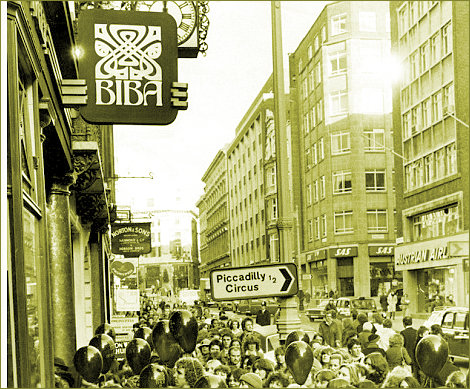 them. Now everyone was getting to hear about them. One day, busty, curvaceous blonde bombshell Diana Dors turned up in a Rolls-Royce.
them. Now everyone was getting to hear about them. One day, busty, curvaceous blonde bombshell Diana Dors turned up in a Rolls-Royce.
She parked on a yellow line, came in and grabbed an armful of clothes. Just as everyone was wondering what she was doing in a shop which pointedly catered only for size eight and ten dolly birds, she marched out of the shop, taking the clothes with her and stuffed them into her Rolls. Hulanicki followed her, dragged her back and put her into a little room she had specially reserved for shoplifters. Diana Dors smiled, and started reapplying her make-up. Word spread, the Press arrived - and the following day, Diana was on all the front pages. It was such a successful publicity stunt that one Saturday afternoon Brigitte Bardot tried to copy her. The outrageous Bardot went even further, stripping off and jumping up and down stark naked in front of the changing room mirrors. Sadly for her, on this occasion the Press failed to arrive.
Biba was always a hands-on enterprise. Barbara and Fitz lived behind the shop and when in 1967 they had a son, Witold, they took him to work every day in his carry cot, along with their Great Dane called Othello.
Tales like this only added to the legend. Soon Biba had moved to huge premises in Kensington High Street, where the shop was appropriately nicknamed Big Biba. In the semi-gloom that Barbara much preferred to overhead lighting, there were plush sofas to recline on and hat stands to display the goods, buckets full of lipsticks and mascara in 24 colours. This mix and match had never been done before either. Finally, a girl could indulge her more outré tastes with black vamp nail polish, long before Chanel revived it, or a pair of spangly wellies, such as Marc Jacobs sells now.
What's more, you could decorate your house to match your clothes - the shop sold black and gold wallpaper branded with Biba's art deco logo. You could even stock your kitchen with Biba branded baked beans from the food hall. As to service, by then the winning formula was well tried. The shop girls were all aspiring models, whose modish looks attracted admiration from friends and boyfriends, who would lounge around the store waiting for them to get off work. They were all as thin as Twiggy. Barbara had a theory about this: people had a much more frugal diet in those days and ate far less meat. And it was before everyone started taking the Pill, which made women much rounder.
As well as looking fabulous, the Biba shop girls knew how to have fun. On Friday nights, for instance, they had a well-tried routine. They all went to the TV studios to see the filming of Ready Steady Go, and, as a result, knew the pop stars of the time as close friends. Because of this, some of the era's leading bands, such as Manhattan Transfer and the New York Dolls, would perform in the so-called Jungle Room on the top floor of the Biba store. That's how Barbara became friends with stars such as David Bowie, Marianne Faithfull and the Rolling Stones' guitarist Ronnie Wood. **
Barbara blames big business for ruining the shop. After a corporate take-over, the men in suits tried to make Biba's friendly ad hoc chaos more organised by installing neon signs showing the way to the various departments. At first, Barbara co-operated and helped design them. Then, one day in 1974, she chucked them all in the bin and stormed out. A year later Biba closed and the backers auctioned off the interior to museums and collectors. The Seventies recession was biting, property prices were going down and the magical mystery decade was over.
Then came the unkindest cut of all. The Biba brand was taken over by Biruta, the original Biba, who had never seen eye-to-eye with her sister.
She briefly opened up an alternative Biba in the West End, but it never took off. As for Barbara, she moved to Miami, attracted by the Art Deco houses on Miami Beach, which she helped to restore. She also designed a music club on the beach for Ronnie Wood. Twelve years after Biba closed, Fitz died of cancer.
Barbara still designs private houses in Florida. The results are beautiful, and she can take added comfort from the fact that these days a vintage Biba fashion original may sell for more than $1,000 in a New York department store. Still, this just isn't the same as when the girl with the Greta Garbo looks defined the Swinging Sixties London scene.
Beyond Biba, a film portrait of Barbara Hulanicki, is released on 20 September

** Not mentioned in this article but Barbara posted a recent picture of Marc Bolan in a Biba Jacket in 1973
1993 - 'I was a Biba Babe' - Kim Wilde
Published in: Sunday - News of the World Magazine (UK) | Date: August 22, 1993 | Written by: Fiona Webster
Not everyone's got the fashion flair for flares. But for Kim Wilde, an original Biba youngster in the Seventies, it's child's play.
When it comes to talent, Kim Wilde's family have got most areas covered. If the 32-year-old needs musical inspiration, she turns to Dad, Fifties idol Marty. While her mum Joyce has inspired the sultry singer's latest look - the swinging London style of shopping emporium Biba. For Kim has put aside the sexy leather dresses of old and rediscovered the famous store of the Sixties and Seventies, where Joyce used to take Kim as a youngster.
"Mum was a keen Biba shopper and my brother Ricky and I loved going with her when I was about 13 or 14. Now I'm wearing the same sort of clothes I watched her buy. In fact, I wore them, too, because Biba had a kid's section which Mum used to choose things from for us. I wish I'd kept them, they're probably worth a fortune now. But we didn't realise then we were part of a mini-fashion legend.
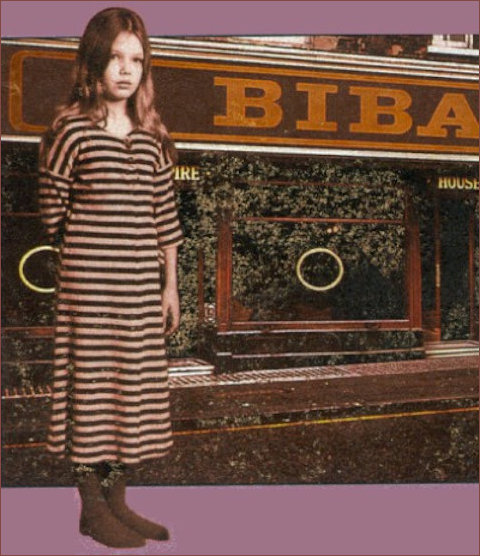
Kim as Mini-Biba
"We lived in Hertfordshire so it was a great treat going to Kensington. Biba was so elegant, very Twenties Art Deco and full of glamorous women. I was mortified when the Biba building in Kensington High Street became a Marks & Spencer. I remember writing it in my diary", she says about the shop which closed for ever in 1975.
"I searched our Mum's old Biba stuff in the attic, but the trouble is her gear is size 8. Though I've bought a lovely Biba-style chiffon dress."
Kim reckons she was an ugly chickling in Biba's heyday. But now the look is back, she can wear the styles that didn't suit her teenage awkwardness. "When I was 13, I was 5ft 6in and my feet were size 6. At my school, you were thought pretty if you were petite with small feet and long hair. I had a middle parting, which was the fashion, but my hair was curly and didn't look right.
"I wanted to wear platforms, but thought they made my feet look even bigger. Now I wear them and have started styling my hair in a centre parting again. I used to wear flares, now I go for flared leather jeans. It's a great look and I'm having more fun wearing Sixties and Seventies fashions today then I did at the time."

All growed up - Kim Wilde
Despite memories of looking gangly, Kim says that her teens were terrific. "The music was brilliant - the Stylistics, Elton John and Wizzard. Dad played the serious stuff at home, like Joni Mitchell and Carole King, which influenced my music, too.
"I was desperate to look like Lynsey de Paul and my ambition was to dance with Pan's People on Top Of The Pops. And Gary Glitter was my hero. No we're friends after sharing a rehearsal room once. He did his act for me in the dressing room, and it was brilliant."
The new look is a big hit with her boyfriend of seven months, Rupert Kenyon, 22, a psychology student in the University of Buckingham. They met at a disco in the posh French skiing resort of Val d'Isere. "He marched up to me and started singing, "We're the kids of Val d'Isere." I couldn't believe his front", she says about the spoof chorus to her hit Kids In America. "But we're still going strong."
She reckons the 10-year age gap doesn't matter. "It's not a problem. We do have differing tastes, but I don't insist that people I have relationships with have the same tastes as me. And I don't feel the need to be involved with someone in the music biz. I love the industry, but you need a balance in life.
"There's no problem having different friends, either. The trouble is, friends only tell you what they really think after the relationship's over. Then it's, 'Oh, we never liked him.'"
Now Kim thinks she may have got it right. "When you reach your 30s, you're more relaxed about things. In your 20s, you make mistakes because you are so eager to get on with life and you come up against a brick wall. As soon as you stop doing that, it tends to have a natural flow", she explains.
Kim's love life before Rupert was almost like the title of her hit, Chequered Love. She split up with Johnny Hates Jazz star Calvin Hayes after two years in 1991. Car dealer Paul Holmes went the same way earlier this year. And just after she split with Calvin, her career was at a standstill, too.
"I was burned out and put on so much weight. I was drinking too much and working too hard. My record company tried to mould the way I looked, but it wasn't me. Though I have to take the blame, too., I did see a doctor, but it wasn't medical help I needed. I thought, 'It's my problem and I'm going to sort it out.'
"First, there was my health. It was an achievement for me to go the gym once a month. Now I go three times a week. I cut down the the booze and now I never drink during the day, though I might have a beer later. I lost more than a stone. Then I got my work into perspective and moved to the country."
The star moved into a £300,000 converted barn in Hertfordshire in 1992. "When I first moved there, I was a bit lonely and resented the countryside. I used to think, 'I'm a London person.' Pathetic really. But I can't see myself slipping back into my bad old ways because I've got so many safety nets. I've got my house and my family, who I see often."
Her family - dad Marty, 54, mum Joyce, 53, plus her brothers Ricky, 31, Marty, 12, and sister Roxanne, 13 - are vital to Kim. "My brothers and sister are very proud of me, there's no jealousy. And they'll always give me an honest opinion of my work, be it good or bad. I'm close to Mum and Dad, and they're so important to my career."
Kim admits she's even been thinking of starting her own family. "I'd love children and if I had them, I would give 100 per cent. I'd give up work for a while, then gear my schedule around my kids. I wouldn't take them touring, as I don't like the idea of leaving them while I go on stage. But them my parents took us everywhere and it didn't do us any harm."
So does Kim have Rupert in mind for the role of father? "No comment, that's private", she laughs.
Her career, like her personal life, is blooming. She's got an album out in September, her first collection of greatest hits, and is also planning a European tour. "I get such a buzz out of touring. I'll have a drink with the lads after the gig, I'm a real rock 'n' roll babe! But I don't drink as much as I used to when I'm performing.
"Now I'd like to get into other things like managing another act, perhaps interior design. But on a small level, nothing as grand as Biba."
1973 - Fashion archive: The seven storeys of Biba
11 September 1973: Fashion store Biba reopens for business in the seven-floor Derry and Toms building on Kensington High Street, London
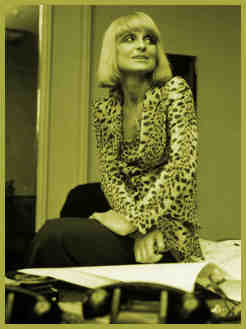
Barbara at the height of her designing powers - sketch pads for the designs, telephones for the sales!
Jenny Cartwright, a shop assistant at the Biba boutique in Kensington, poses in the shop's household department, 10 September 1973. Photograph © : Graham Wood/Getty Images
The big new Biba opened yesterday in the old Derry and Toms building, Kensington High Street. Barbara Hulanicki, alias Biba, opened her first boutique in an old apothecary shop in Abingdon Road, Kensington. Three moves later Biba now occupies a huge seven floor store, a far cry from the cheap but original dolly bird fashion concept which Barbara Hulanicki's boutique once was. The new store is designed by Steve Thomas and Tim Whitmore, and supervised by Miss Hulanicki herself.
Here is a store with a design-for-living concept throughout. Biba has grown in stature to provide a way of life. The basement has a food hall, including take-away eats. The ground floor has accessories, cosmetics, 24 shades of tights, posters, playing cards, balloons, books and stationery. The first floor is fashion - an extension of what Biba always was, only more so, with familiar hat stands dotted with new designs, and open plan changing rooms. Further up is rose coloured art deco glass, satin fringed lampshades, rooms set in Biba style (one aptly called the The Bad Taste Room), a lot of kitsch china and glass, plaster ducks, bentwood rockers, and basket wear.
The vast Rainbow Room occupies the entire fifth floor, retaining its original ceiling and crockery and the room logo of a dancing couple. It is open 9.30 to 2.30 Monday to Saturday, 10 to midnight on Sundays, self-service or waitress service.
The picture (below) shows Martine Chevant wearing black/silver pailletted evening top, sizes S, M, L, £11.90 with long grey crepe skirts £12.25. Red sequinned pillbox £4.40; silver/black choker £23.50, diamante earrings £2.40; clear Perspex/gilt bangles £1.90; sequinned clutch bag, £7.95; silver/black T strap shoes also in gold/black £8.95, all from Biba, Kensington High Street, London W8.
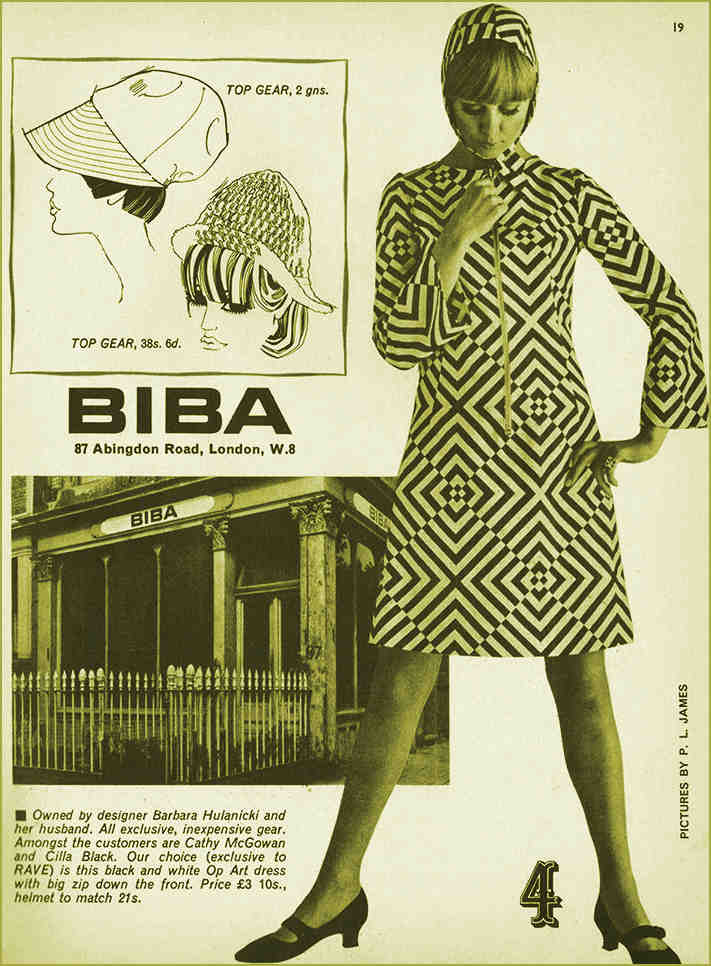
Biba (original logo) still at Abingdon Road catering to the style of the day - only a hint of what was to come!
No wonder Barbara chose fashion & Illustration
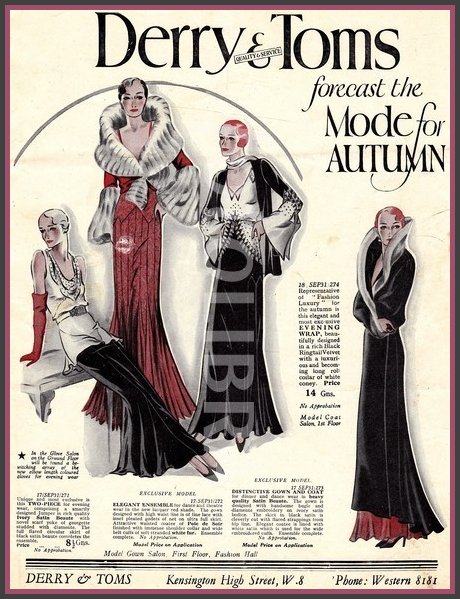
I think I would have chosen fashion as well!
Page updated : 18th February 2018 (G)
